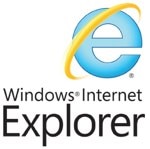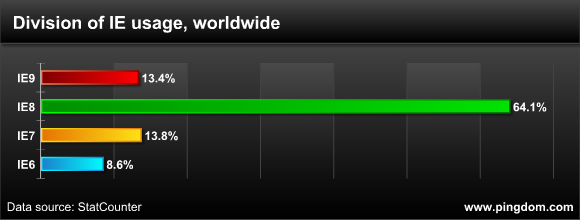 Internet Explorer 9 launched on March 14 this year, a full three months ago. It’s free software. It’s clearly a better web browser than previous IE versions. Yet only 13% of IE users have adopted IE9 so far. In other words, IE9 adoption is going… kinda slowly.
Internet Explorer 9 launched on March 14 this year, a full three months ago. It’s free software. It’s clearly a better web browser than previous IE versions. Yet only 13% of IE users have adopted IE9 so far. In other words, IE9 adoption is going… kinda slowly.
Compare that with the adoption of Firefox 4. It was launched on March 22, just over a week after IE9, yet 56% of Firefox users are already running Firefox 4. It’s been downloaded more than 200 million times and counting (the current count is 218 million).
The installed user base for IE overall is of course larger than that of Firefox, so there are more users to shift. Even considering that, the difference between the upgrade ratios is still staggering, 58% versus 13% over almost exactly the same amount of time.
We’ll have a look at why this is the case, what’s coming in the near future, and how possibly Google could lend a helping hand (sort of).
The current overall situation for IE
Here is what the current division of IE usage looks like for the first 13 days of June, worldwide:

Microsoft actually has the most fragmented user base of all browser makers, i.e. there is a significant amount of users for each of the IE versions.
There are even more people still using IE7 than IE9. Go figure. Perhaps not surprising, though, since those are bound to be people who wouldn’t upgrade to IE8 either. And we suspect Microsoft isn’t too happy about that IE6 number.
Why are IE users so slow to upgrade?
One really has to ask why IE users are so slow to upgrade. This often seems to be the case with Microsoft. They simply can’t get their users to upgrade, for whatever reason. Remember all those people still clinging to Windows XP?
A majority of IE users are probably completely unaware that IE9 even exists. Then there’s also the fact that IE9 won’t work on Windows XP, which still makes up a huge chunk of all Windows installations. To make matters worse, the next version of IE (IE10) won’t work in Windows Vista, so the problem will escalate unless Microsoft can get their users to upgrade their operating systems as well.
Is Microsoft’s IE user base really that fundamentally different from for example the Firefox user base? Is it on average less tech savvy, less eager to stay on the cutting edge? It’s difficult to draw any other conclusion.
To some extent it is also a matter of less aggressive upgrade mechanics, of the choices presented to the users. Firefox actively encourages its users to upgrade when there are new versions, something Microsoft isn’t doing in IE (at least not directly in the application). And as you know, Google Chrome upgrades automatically, circumventing this problem entirely (more on this later).
Windows Update to the rescue?
Speaking of upgrade mechanics, Microsoft plans to push out an upgrade through Windows Update later in June. Users will still have to approve the upgrade, but it will be interesting to see how the stats change after that. If they remain low, Microsoft is in trouble.
That still doesn’t change the fact that so few of Microsoft’s IE users have upgraded on their own, and many are clinging on to very old versions. IE9 has been out there for three months now, which in Web Land is a pretty long time.
Will Google’s browser concepts help IE?
Google has contributed two great things with the Chrome web browser:
- A focus on performance, especially JavaScript performance, which forced other browser maker to take performance more seriously.
- Completely automated, behind-the-scenes upgrades. The user isn’t even aware of which version he/she is running, just that it’s always the latest.
The second point of course being what’s relevant to this article.
Google proved to the other browser makers that those automated upgrades work well, and that users don’t mind giving up that control. Not so strange then that Mozilla is also planning on incorporating automatic upgrades in their browsers, starting with Firefox 5, and we’d be very surprised is Microsoft is planning something similar for future versions of IE.
We’ve talked about why automated browser upgrades are a Good Thing ™ before, but it’s worth reiterating:
- Silent upgrades mean users don’t have to be annoyed with frequent upgrade messages. Great for users, and great for developers since they can develop the product at a rapid pace. This should have a positive effect on innovation.
- Users will always be running the latest, best version.
- Developers don’t have to support old versions of the software.
- Since developers can assume that users will be running the latest version, they can USE the latest features and assume they are there, which helps them innovate.
- Old software can be a security threat if left unpatched.
In general, a speedy upgrade process is important to the development of the Web as a platform. Modern browser features and standards support are only relevant when there is a large installed user base that supports those features. Web developers, web designers, everyone has a shared interest in having their users adopt the latest browser versions.
For Microsoft, this means getting out of the fragmentation hell it is currently enjoying in the web browser area, and although it will take a while, the automated browser upgrades pioneered by Chrome is the way forward. Now they just need people to start upgrading from Windows XP and Windows Vista, or they will be stuck regardless.
Data source: The browser stats are from StatCounter, for the first 13 days of June.


























